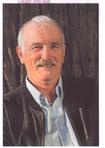John Michael McCarty's Blog, page 14
September 27, 2016
Beach Chalet Restaurant in San Francisco
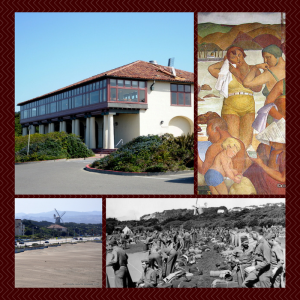 The Beach Chalet restaurant in San Francisco was established in 1925. My friends and I would use the changing rooms on the ground floor of the Spanish Revival building before venturing across the street to Ocean Beach and the freezing waters of the Pacific. For a special treat, my dad would take us upstairs for a Shirley Temple where another two hundred patrons would be sitting.
The Beach Chalet restaurant in San Francisco was established in 1925. My friends and I would use the changing rooms on the ground floor of the Spanish Revival building before venturing across the street to Ocean Beach and the freezing waters of the Pacific. For a special treat, my dad would take us upstairs for a Shirley Temple where another two hundred patrons would be sitting.
The frescoes in the lounge depict a simple and casual life of San Francisco. I was quickly reminded, however, that life during the Great Depression was anything but simple. Those boys at the WPA (Works Project Administration) must have had a sense of humor.
There was nothing funny about what came next. The attack on Pearl Harbor ushered in WWII. Mom was typical of many civilians back then, fearing that the Japanese’s next target would be the West Coast. The Army must have felt the same way, shoring up their defenses around the City.
Beach Chalet:
The military commandeered Beach Chalet for use as its Coastal Headquarters. Dad and his buddies camped in Golden Gate Park, providing an extra line of defense until getting shipped overseas. After the war, the VFW (Veterans of Foreign Wars) used the upstairs as a meeting room while the downstairs became a biker bar of disrepute. Those bad boys! In 1951 the VFW moved out and the place was shuttered. It was padlocked and surrounded by a chain link fence, which only enticed the curiosity of feral cats, vagrants and more than a few of my friends. Eventually over two million dollars from City coffers and private grants enabled the restaurant to reopen in 1996. My favorite spot inside is the Park Chalet, a sunny filled garden cafe, but don’t overlook the brewery upstairs. Tasty!
The post Beach Chalet Restaurant in San Francisco appeared first on John McCarty.
September 15, 2016
The Hideaway saloon in west Sonoma County
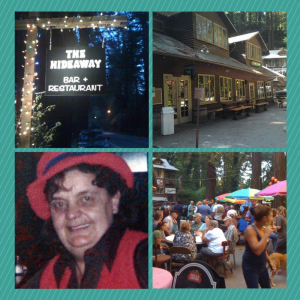 The Hideaway saloon in west Sonoma County sits on the same site as the 1870 Montesano Station, which served as a depot for the Guerneville & Russian River R.R. line. The structure burned down in 1920 but not before witnessing the grand ol’ days of the lumber industry. The present building was built on the original foundation, perhaps explaining why until recently not a square or plumb inch could be found. For decades the roofline and windows were cockeyed, which seemed a good fit for the eclectic bunch of characters who frequented the joint. At one time there were several cabins out back for rent while the main lodge served as inn and local watering hole. Historical legend states that the upstairs housed a six-room brothel back in the day, all the while playing host to a number of supernatural guests. Former employees testify that they have had numerous encounters of the prankster kind with Evelyn Ripkin, a deceased owner from the Depression era.
The Hideaway saloon in west Sonoma County sits on the same site as the 1870 Montesano Station, which served as a depot for the Guerneville & Russian River R.R. line. The structure burned down in 1920 but not before witnessing the grand ol’ days of the lumber industry. The present building was built on the original foundation, perhaps explaining why until recently not a square or plumb inch could be found. For decades the roofline and windows were cockeyed, which seemed a good fit for the eclectic bunch of characters who frequented the joint. At one time there were several cabins out back for rent while the main lodge served as inn and local watering hole. Historical legend states that the upstairs housed a six-room brothel back in the day, all the while playing host to a number of supernatural guests. Former employees testify that they have had numerous encounters of the prankster kind with Evelyn Ripkin, a deceased owner from the Depression era.
The Hideaway:
One of the longtime fixtures at The Hideaway was Angie Stanford. She ran the place for forty-six years always greeting customers with her blue-collar, Austrian accent. She stood under five feet tall, needing the assistance of risers in order to serve a libation. It was always an interesting encounter when ex-Niner Bob St.Clair walked into the bar and smothered her with his 6′ 9″ frame. But you had better not take her diminutive stature for granted. She was as tough as they came. On one occasion a band of bikers rolled into the parking lot wearing scruffy beards and club patches. Angie told her patrons to relax as she promptly exited and ordered the thugs to vamoose. Bred from old-school values, she wouldn’t tolerate any misbehavior. She once eighty-sixed a man for being impolite to his wife while booting out another for foul language. And if you didn’t like the stiff drink she poured, you might find the door as well. Gracious to a fault (and her pocketbook), the first beverage was always on the house. Angie Stanford passed away on May 26, 2015 and is residing with her husband George in heaven. Here’s to you, Angie!
The post The Hideaway saloon in west Sonoma County appeared first on John McCarty.
September 10, 2016
The Ramp in San Francisco
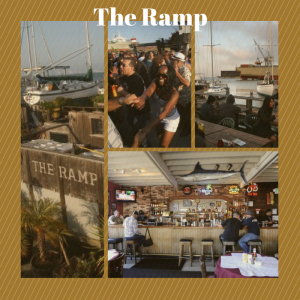 The Ramp in San Francisco is one of the few public boat ramps in the City and is a favorite saloon and eatery. Located in China Basin, it opened in 1950 as a bait shop and is still one of those colorful venues that the locals can call their own. You can be yourself here, sharing local maritime lore as well as taking in the industrial sights. Don’t let anyone catch you drinking a Corona from a glass. No, sir, not here. And your mutt won’t be the only critter raising its snout at the mixture of scents. The charcoal aromas of barbecued shrimp and steaks meld with the salty, fishy taste of the waterfront and the sound of sanders buffing out the hull of a yawl nearby. Part of the property has been retooled into the San Francisco Boat Works, the last remaining boat yard in the City.
The Ramp in San Francisco is one of the few public boat ramps in the City and is a favorite saloon and eatery. Located in China Basin, it opened in 1950 as a bait shop and is still one of those colorful venues that the locals can call their own. You can be yourself here, sharing local maritime lore as well as taking in the industrial sights. Don’t let anyone catch you drinking a Corona from a glass. No, sir, not here. And your mutt won’t be the only critter raising its snout at the mixture of scents. The charcoal aromas of barbecued shrimp and steaks meld with the salty, fishy taste of the waterfront and the sound of sanders buffing out the hull of a yawl nearby. Part of the property has been retooled into the San Francisco Boat Works, the last remaining boat yard in the City.
This is a nice, funky place where one checks the hoity-toity attitude at the door and enjoys al fresco dining under the collection of mismatched umbrellas.
The Ramp:
Nearly all the action at The Ramp takes place outdoors on the wooden deck where you’ll find people of all manner kicking up their heels to live salsa and Brazilian music. Construction hardhats from UCSF mingle with boat workers and Mission High teachers and long established residents from Hunters Point and Mission Bay. The diverse clientele go out of their way to support this hidden gem, a gem replete with decay, pungent aquarium odors, screeching birds and a scene reminiscent of what the REAL City must have looked like decades ago. And we wouldn’t have it any other way!
Note: For a treat, take another peek at Woody Allen’s movie Blue Jasmine for a cameo shot of The Ramp. Cheers!
The post The Ramp in San Francisco appeared first on John McCarty.
August 29, 2016
The Saloon in North Beach, San Francisco
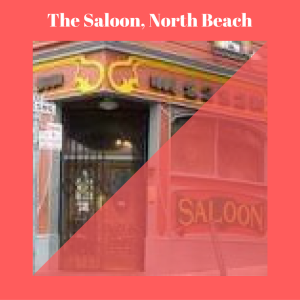 The Saloon in North Beach, San Francisco, is located on Grant Street just a couple of doors up from Broadway. It first opened in 1861, making it the oldest drinking establishment in the City. The building looks much the same as it did way back during those infamous Barbary Coast days when it offered 5-cent Bavarian beer, 10-cent hot Scotch Punches, and cigars. The wooden bar, which was installed in the 1860’s and made overseas, is still in use. At its base, a tiled trench (from yesteryear as well) runs under the the stools, once used as a spittoon and occasionally as a urinal (perhaps during modern times also).
The Saloon in North Beach, San Francisco, is located on Grant Street just a couple of doors up from Broadway. It first opened in 1861, making it the oldest drinking establishment in the City. The building looks much the same as it did way back during those infamous Barbary Coast days when it offered 5-cent Bavarian beer, 10-cent hot Scotch Punches, and cigars. The wooden bar, which was installed in the 1860’s and made overseas, is still in use. At its base, a tiled trench (from yesteryear as well) runs under the the stools, once used as a spittoon and occasionally as a urinal (perhaps during modern times also).
The Saloon was one of those places where easy targets were drugged, hauled up to the east side of nearby Telegraph Hill and imprisoned in one of the Filbert Step cottages to be shanghaied out to sea later. The 1906 earthquake and fire destroyed most of the buildings in the area but not The Saloon.
The Saloon:
During the 1906 disaster, a Navy frigate supposedly pumped water from the bay via a hose which was extended over Telegraph Hill to North Beach. The Saloon and a wholesale liquor warehouse were examples of the few structures saved in the district. Some have said that alcohol businesses received preferential treatment from the firefighters. I don’t see the problem here.
During the sixties and seventies, Grant Street was known for its blues bands, playing music every night. Over the years, The Saloon has hosted talented and sometimes famous musicians such as Johnny Nitro, Steve Miller and Etta James. In recent times, it has been recognized by the Blues Foundation of Memphis for keeping the sound alive. Try it out.
The post The Saloon in North Beach, San Francisco appeared first on John McCarty.
August 28, 2016
Gino and Carlo in San Francisco
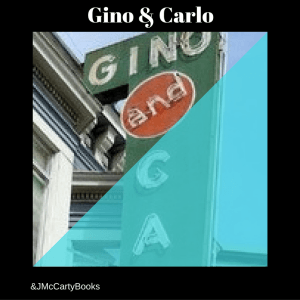 Gino and Carlo in San Francisco was established in 1942 and a family operated saloon for more than fifty years. The North Beach bar on Green Street has always been known for their cheap drinks, easy vibe and great characters. Frank was a sweetheart behind the bar–low key, mellow and knew your name. Carol Doda would visit after her show sometimes. Pool players and fantasy-sport enthusiasts also gathered here. There might even be a guy hanging out in the shadows with a fedora on, a Godfather waiting to be received.
Gino and Carlo in San Francisco was established in 1942 and a family operated saloon for more than fifty years. The North Beach bar on Green Street has always been known for their cheap drinks, easy vibe and great characters. Frank was a sweetheart behind the bar–low key, mellow and knew your name. Carol Doda would visit after her show sometimes. Pool players and fantasy-sport enthusiasts also gathered here. There might even be a guy hanging out in the shadows with a fedora on, a Godfather waiting to be received.
I remember this time when I got into a conversation with a regular, an old-salt Italian. Let’s call him “Alfredo”. Alfredo started telling this tale about how he was dining at a neighborhood eatery/bar when the owner approached and suddenly collapsed.
Gino and Carlo:
The gentleman died right there in front of Alfredo’s booth. Alfredo turned and said to me, “You know what, John, I had to walk over the S.O.B. to get to the bathroom. Some nerve, huh?”
Years later I accidentally ran into Alfredo while I was working behind the register at Northwood Golf Course up at the Russian River. He strolled in with two behemoths. These guys must have weighed 300 pounds each, six-foot-five, and wore starched white T-shirts, black slacks and black Oxfords. In a soft, even tone, Alfredo asked me politely if there was a chance he could get out to play some golf. I asked how many players would there be. Alfredo said just himself, that he liked playing alone with the exception of his two compadres who would be just riding along. I gazed over at the two hulks, the pair standing stiff with arms folded and said that there would be no problem. Gino and Carlo is a great bar, great color and great stories. Don’t miss out!
The post Gino and Carlo in San Francisco appeared first on John McCarty.
August 21, 2016
Game Three of the 1989 World Series
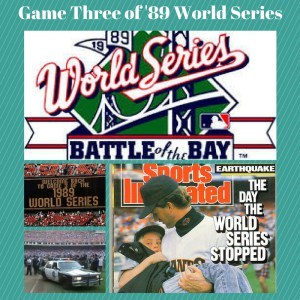 Game three of the 1989 World Series occurred on October 17th. The Oakland A’s had won the two previous outings but the Say-Hey-Kids of the City knew better than to count themselves out. Then it happened. At 5:04 p.m. Candlestick shook under the wagging finger of a 6.9 jolt. And it was all caught on live T.V., a first. Al Michaels cut in on Tim McCarver’s highlights to say, “You know what, we’re having an earth…” and the feed went dead.
Game three of the 1989 World Series occurred on October 17th. The Oakland A’s had won the two previous outings but the Say-Hey-Kids of the City knew better than to count themselves out. Then it happened. At 5:04 p.m. Candlestick shook under the wagging finger of a 6.9 jolt. And it was all caught on live T.V., a first. Al Michaels cut in on Tim McCarver’s highlights to say, “You know what, we’re having an earth…” and the feed went dead.
There was a loud rumble as the bleachers in right field swayed, fans dashing toward the exits during those frantic fifteen seconds. A worker on a light tower could be seen holding on, his body slapping in the wind like a rag doll. One fan yelled, “Yeah, rock the Bay!” and a rally cry was born. Players milled around the infield with their young ones hiked upon their shoulders. Twenty minutes passed and everyone knew that the game was in jeopardy.
Third Game of 1989 Series:
The announcers confirmed everyone’s fears and the boosters began to file out, confused and disappointed. The Series would not restart for ten days, the longest delay ever, and the Oakland A’s would eventually win in a sweep. The quake killed sixty-three people, injured 3,757 and left 12,000 others homeless. Out of respect for these victims, the A’s were not allowed the traditional celebration with champagne.
The post Game Three of the 1989 World Series appeared first on John McCarty.
August 18, 2016
1989 Loma Prieta Earthquake
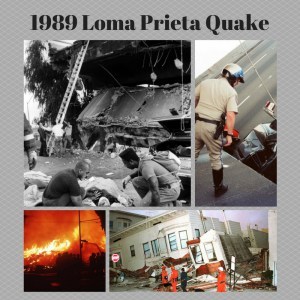 The 1989 Loma Prieta earthquake occurred in northern California on October 17th at 5:04 p.m. At the time my wife and I were living part-time on a boat in the Marina District of San Francisco. Huge support poles for the docks and ships’ masts began to crisscross each other. A lady screamed from Marina Blvd. Cars crashed. Honks blared. Propane tanks exploded. Flames shot up. I left a blank T.V. & the World Series behind and went to the parking lot where everyone gathered around a pickup and its radio. Broadcasters sent out alarms, stating that the downtown was buried under eight feet of glass, that the Bay Bridge was down, that the Nimitz Freeway had collapsed.
The 1989 Loma Prieta earthquake occurred in northern California on October 17th at 5:04 p.m. At the time my wife and I were living part-time on a boat in the Marina District of San Francisco. Huge support poles for the docks and ships’ masts began to crisscross each other. A lady screamed from Marina Blvd. Cars crashed. Honks blared. Propane tanks exploded. Flames shot up. I left a blank T.V. & the World Series behind and went to the parking lot where everyone gathered around a pickup and its radio. Broadcasters sent out alarms, stating that the downtown was buried under eight feet of glass, that the Bay Bridge was down, that the Nimitz Freeway had collapsed.
The overhead wires stopped putting out electricity. The wife disembarked from her commuter bus just outside the Stockton Tunnel in Chinatown and began her three-mile trek to the boat. Wide-eyed pedestrians scurried around, traffic jammed up at intersections, signals on the blink, glass everywhere. She passed through Ghirardelli Square and Fort Mason until she came to Great Meadow Park and scanned the devastation of the Marina District for the first time.
Loma Prieta Earthquake:
She gaped in shock at the sight of the smoke and flames. With the unknown on her mind, she wondered where I was, if I was still across town at work. Unable to communicate with me, she ventured on toward our boat. Upon reaching the Marina Green, the ground underneath sloshed up from the liquefaction. Men recruited other able-bodied souls to help run hoses from a distance as the nearby hydrants were on the fritz. A fountain of fire spewed upwards from a ruptured gas main.
Later that evening, we were one of the few who were not evicted from the area. It was a surreal scene. No traffic with the exception of police and other emergency vehicles as red and blue orbs flashed throughout the night. Loudspeakers demanded citizens to vacate the neighborhood. Bleeping sirens warned potential looters. Street lamps went dark. The fireboat Phoenix tied up and began pumping bay water to the fire engines on shore.
The next day we meandered across the yellow tape with others, the smell of gas heavy in the air. I noticed a familiar building, but something wasn’t right. At first there appeared to be no structural damage, everything intact as I had remembered. But upon closer inspection, the unfathomable came alive. The four-story residence had given way evenly on all its corners. The second floor was now level with the sidewalk, not a single doorway present. Gone was the garage, entrance and lobby. What were your memories of Oct. 17, 1989?
The post 1989 Loma Prieta Earthquake appeared first on John McCarty.
August 13, 2016
San Francisco Moratorium Peace March
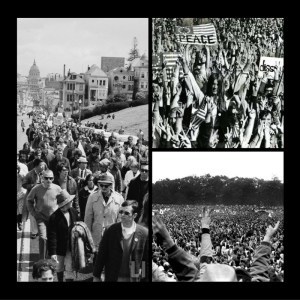 In November of 1969, 100,000 protestors took to the streets for the San Francisco Moratorium Peace March. I was there as we assembled at Kimbell Park in the Western Addition and wound our way along Geary Blvd. for the four-hour journey to Golden Gate Park, ending up at the Polo Fields for a rally. The Tet Offensive was in full swing, as North Vietnamese regulars pushed into the south. American bodies were needed. Nearly 500,000 U.S. troops were deployed to the conflict, a tenth of that number never coming home.
In November of 1969, 100,000 protestors took to the streets for the San Francisco Moratorium Peace March. I was there as we assembled at Kimbell Park in the Western Addition and wound our way along Geary Blvd. for the four-hour journey to Golden Gate Park, ending up at the Polo Fields for a rally. The Tet Offensive was in full swing, as North Vietnamese regulars pushed into the south. American bodies were needed. Nearly 500,000 U.S. troops were deployed to the conflict, a tenth of that number never coming home.
Those who were protesting the protestors argued that the marchers were all left wing agitators imported from the outside. As evidence they photographed the Communist Party of the U.S., which participated openly with their banner. Labor unions were present with their flags as well, but for the most part the throng consisted mostly of Mr. and Mrs. Average America, walking alongside teachers, scientists, librarians, firemen and even downtown suits.
1969 Peace March:
The 1969 Peace March culminated in a rally at the Polo Fields around 2:00 p.m. with such keynote speakers as Rev. Ralph Abernathy, Senator Morse from Oregon, and Black Panther leader, David Hilliard, who was drowned out with chants of “peace” when he began preaching violence. The cast of “Hair” performed some of their songs while protestors danced, threw confetti and sung “Let the Sun Shine”. Led by Professor Pierre Noyes of the Stanford Linear Accelerator Center, it was announced that a taxpayers’ suit would be filed against the United States, claiming that no war had been officially sanctioned by Congress.
While the Vietnam War was the creation of men in government, the brunt of the protest was thrown upon the soldier himself/herself. Several of my friends came home from the unofficial war only to be spat upon and cursed at. They were just doing their duty, a duty defined and demanded upon them by fear-mongering politicians.
The post San Francisco Moratorium Peace March appeared first on John McCarty.
August 11, 2016
Hippie Hill in San Francisco
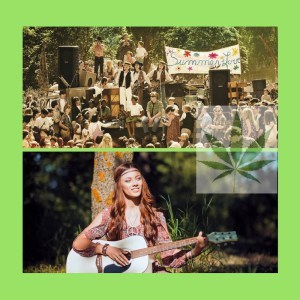 Sun rays pushed their way thru the wisps of fog, which hovered above the lawn of Hippie Hill in San Francisco. During the Summer of Love protestors, musicians and young people came together to take in the sweet smells. Pass the joint and celebrate, for their was much to be thankful for. On any one day in ’67, you might visit the knoll at the east end of Golden Gate Park and spy Charles Manson lecturing on the evils of desegregation or Captain Trips playing with The Dead or Peter Coyote recruiting troops for his anarchist Diggers.
Sun rays pushed their way thru the wisps of fog, which hovered above the lawn of Hippie Hill in San Francisco. During the Summer of Love protestors, musicians and young people came together to take in the sweet smells. Pass the joint and celebrate, for their was much to be thankful for. On any one day in ’67, you might visit the knoll at the east end of Golden Gate Park and spy Charles Manson lecturing on the evils of desegregation or Captain Trips playing with The Dead or Peter Coyote recruiting troops for his anarchist Diggers.
Drum circles, swirls of smoke and dancing were common scenes, everyone connecting with each other and the universe, dropping acid, throwing out smiles. You might even look up toward the Janis Joplin Tree and catch a wild-eyed girl with her guitar. To this day it is still one of the best people-watching places in the City.
Hippie Hill:
Hippie Hill and drugs were synonymous, soul mates to the bitter end. Back in the day, many hallucinogens such as LSD were new on the scene, not even catalogued by government agencies and, therefore, legal and sold without threat of arrest. You can still get a taste of the past by visiting Hippie Hill on 4/20. Some 8,000 believers skipped to the spot this last April to reminisce and take a hit on the memories of yesteryear.
Sidebar: A group of San Rafael High School students in 1971 first used the term 4:20, referring to their gathering time after the last class was let out. They called themselves the “Waldos”, as they met near a popular wall where they searched for an abandoned cache of weed, based on a treasure map supplied by the grower. No bogarting allowed.
The post Hippie Hill in San Francisco appeared first on John McCarty.
July 30, 2016
Hells Angels and Acid
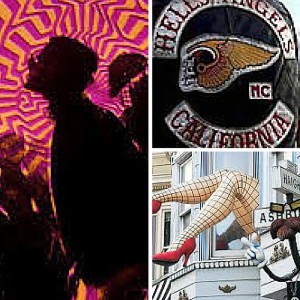 The Hells Angels and acid began their chaotic relationship in 1966 down at Ken Kesey’s farm in La Honda along the San Francisco peninsula. Kesey was fresh off a commercial success with his novel, One Flew Over the Cuckoo’s Nest, and celebrated by hosting Acid Test gatherings with plenty of LSD. Sonny Barger and George Wethren and some of their other biker-club bros visited one of the happenings along with a mixture of Bohemians, Stanford grads, musicians and others. The bad boys of Oakland had acquired a liking for the little known chemical. They floated in and out of the lush redwood groves, taking long journeys to Psychedelia, exploring females who graced themselves like Eve upon a garden of ferns. Barger orbited beyond his known experience, the universe exploding into neon blues and yellows and reds, orgasms on a runaway train of laughter and pain and holiness. To this East Bay banger, marijuana was lost smoke when compared to the miracles of LSD.
The Hells Angels and acid began their chaotic relationship in 1966 down at Ken Kesey’s farm in La Honda along the San Francisco peninsula. Kesey was fresh off a commercial success with his novel, One Flew Over the Cuckoo’s Nest, and celebrated by hosting Acid Test gatherings with plenty of LSD. Sonny Barger and George Wethren and some of their other biker-club bros visited one of the happenings along with a mixture of Bohemians, Stanford grads, musicians and others. The bad boys of Oakland had acquired a liking for the little known chemical. They floated in and out of the lush redwood groves, taking long journeys to Psychedelia, exploring females who graced themselves like Eve upon a garden of ferns. Barger orbited beyond his known experience, the universe exploding into neon blues and yellows and reds, orgasms on a runaway train of laughter and pain and holiness. To this East Bay banger, marijuana was lost smoke when compared to the miracles of LSD.
Hells Angels and Acid:
At La Honda, the Hells Angels met Owsley Stanley, also known as Bear, who was the sound manager for the Grateful Dead. But what Barger and the boys were most taken with was Owsley’s wizardry with hallucinogens. And not just the quality of the product but the quantity. Owsley was the first private individual to manufacture mass quantities of LSD, producing more than ten million doses between 1965-1967. George Wethren saw an opportunity and convinced Owsley that the Hells Angels should be the main pipeline into the Haight of LSD. The Angels handled both wholesaling and retailing, enjoying a near monopoly of acid distribution in San Francisco. The club’s reputation for quick and thorough retribution discouraged snitches. Territorial challenges, however, were common place. Gone were the days when dealers made their rounds with thousands of dollars in their jeans.
More to come in John McCarty’s next novel, Don’t Stop the Music.
The post Hells Angels and Acid appeared first on John McCarty.

